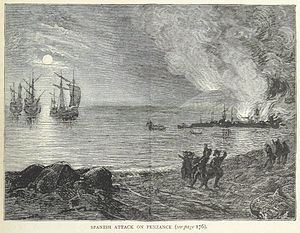Dates 1 Aug 1595 – 2 Aug 1595 | Result Spanish victory | |
 | ||
None 4 settlements and 1 fort razed
4 ships sunk Combatants United Kingdom, Spanish Empire Similar Battle of Berlengas Islands, Battle of the Strait of Gibraltar, 2nd Spanish Armada, Action of Faial, Battle of Flores (1592) | ||
The Battle of Cornwall was a Spanish raid on Cornwall in 1595 during the Anglo-Spanish war of 1585-1604. It was conducted by a Spanish naval squadron from Brittany, France.
Landings
Carlos de Amesquita commanded three companies of arquebusiers (about 400 men in total) and four galleys (Nuestra Señora de Begoña, Salvador, Peregrina and Bazana) from the fleet under Pedro de Zubiaur. He sailed from Port Louis, Brittany, on 26 July. After calling at Penmarch, they sank a French barque manned by an English crew and with a cargo bound for England.
Amesquita's forces eventually landed at Mount's Bay, Cornwall on 2 August. Amesquita was guided by English Catholic Richard Burley of Weymouth. The local militias, which formed the cornerstone of their anti-invasion measures and numbered several hundred men, threw down their arms and fled in panic. Only Francis Godolphin, Deputy Lord Lieutenant of Cornwall and commander of the militias along with 12 of his soldiers stood to offer some kind of resistance. In two days the Spanish took all they needed, burning Penzance and the villages of Mousehole, Paul and Newlyn, as well as taking cannons from the forts in the area and re-mounting them on their fleet. The town of Penzance had also been bombarded by the Spanish galleys; 400 houses were destroyed and three ships were sunk.
At the end of the campaign a traditional Catholic mass was held on English soil and, on re-embarking soon afterwards on 4 August, the Spanish commander promised to build a Catholic church on its site once England had been conquered. He then left all his prisoners ashore and evaded a fleet sent against them under Francis Drake and John Hawkins. On 5 August Amesquita met a Dutch squadron of 46 ships, sinking two of the Dutch ships and causing much damage to the others but also suffering casualties (20 men killed) before the rest of the Dutch ships escaped. He then stopped at Penmarch for repairs and finally arrived back at Port Louis on 10 August.
